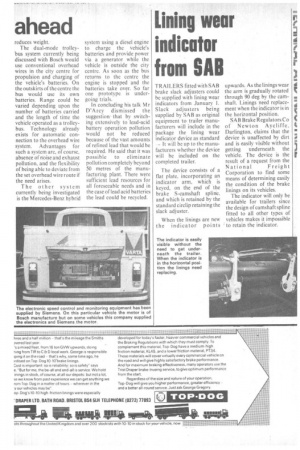1Lead-acid batteries are still ahead
Page 22

Page 23

If you've noticed an error in this article please click here to report it so we can fix it.
ALTHOUGH Varta Batterie AG was working on three electro chemical storage cells, of which sodium sulphur seemed the most promising, existing and developed lead-acid systems would still be the main source of mobile energy for battery powered vehicles in the foreseeable future.
This was the view of Mr Rainer-Lionel D'Arcy, general manager, of the traction division of Varta, the German battery manufacturer, when he was speaking to visitors at a seminar organized by Varta in Manchester last week. Mr D'Arcy said that ic engines were at the moment developing specific power outputs of between 12kg/kW and 2.5kg/ kW while battery systems were providing between I Wit/ kg to the 40Whikg of the MAN bus project.
There would always be a problem of.range, even with the higher energy cells under development but an important factor in considering whether batterypowered vehicles could become generally acceptable for a wide number of applications was the ability to provide the necessary infrastructure, such as charging or changeover stations, for such vehicles.
Another important factor restricting electric development was the reluctance of vehicle manufacturers to become involved — although Mr D'Arcy thought this was a natural reaction until there was enough evidence to suggest which way development would go.
Bus and truck applica tions seemed the most suitable for battery propulsion at the moment because their routes and periods of operation could be determined in advance. This helped to make the most economical use of battery packs.
On the MAN, Varta supplied the complete battery packs and interface between motor and control system. Mr D'Arcy emphasized that it was important to understand that the battery was not an entity in itself but only part of a complete power system. The company has developed monitoring equipment which provides complete information on battery state, including the number of charge-discharge cycles, and total energy which has been used. Using this equipment on the MAN project the drivers, apparently, have been having daily competitions to see who can complete a route using the least energy.
Cooling the batteries by fan has played a large part in extending battery life and range on the bus project. The cells themselves are of a new construction, being encased in polypropylene, which greatly reduces weight. Water topping up and degassing is completely automatic, using "cornbinators" consi§ting of hydrogen and oxygen elements which combine to provide the necessary water. In addition, the cells are completely leak proof which allows the use of copper, instead of lead, connecting straps. This increases conductivity and also allows movement between cells resulting from vehicles, vibration, and also reduces weight.
The dual-mode trolleybus system currently being discussed with Bosch would use conventional overhead wires in the city centre for propulsion and charging of the vehicle's batteries. On the outskirts of the centre the bus would use its own batteries. Range could be varied depending upon the number of batteries carried and the length of time the vehicle operated as a trolleybus. Technology already exists for automatic connection to the overhead wire system. Advantages for such a system are, of course, absence of noise and exhaust pollution, and the flexibility of being able to deviate from the set overhead wire route if the need arises.
The other system currently being investigated is the Mercedes-Benz hybrid system using a diesel engine to charge the vehicle's batteries and provide power via a generator while the vehicle is outside the city centre. As soon as the bus returns to the centre the engine is stopped and the batteries take over. So far one prototype is undergoing trials.
In concluding his talk Mr D'Arcy dismissed the suggestionthat by switching extensively to lead-acid battery operation pollution would not be reduced because of the vast amounts of refined lead that would be required. He said that it was possible to eliminate pollution completely beyond 50 metres of the manufacturing plant. There were sufficient lead resources for all foreseeable needs and in the case of lead acid batteries the lead could be recycled.




























































































